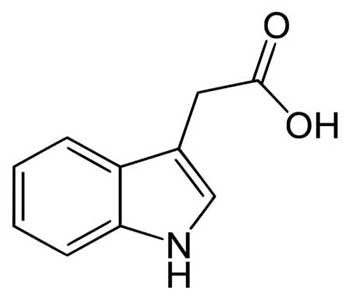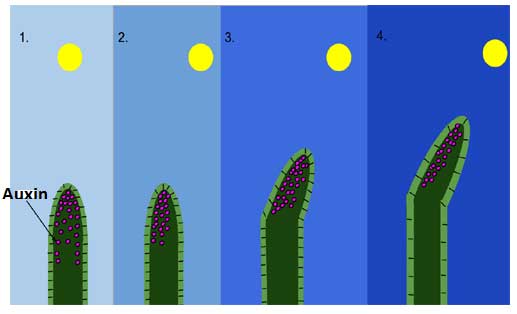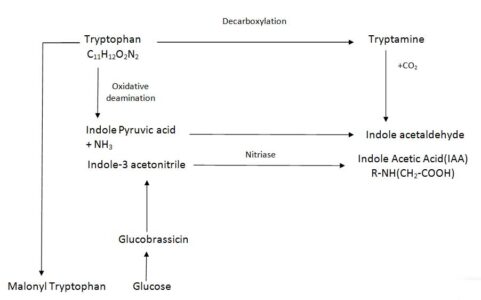Auxin is a indole radicle plant hormone which is produced by growing tip of a coleoptile and influence growth rate of the cells and also encourages the length of roots and stems of plants.
This type of hormone contains different types of organic acid. The plant hormone auxin and its role were first discovered by Frits Warmolt Went (Dutch biologist) in 1920. Kenneth V. Thimann first isolated the auxin from the plant body and he also demonstrated its chemical structure as indole-3-acetic acid (IAA).
Axuin contains three types of organic substances such as Auxin-a, Auxin-b and Hetero auxin. Chemically, auxin-a is called auxenotriolic acid (C18H32O5), auxin-b is auxenolonic acid (C18H30O4) while hetro-auxin is called indole acetic acid(IAA-C10H9O2N).

Chemical Structure of Auxin
Both auxin-a and auxib-b are stable in heat and light and can be oxidised easily. Hetero-auxin is present in maize grain, in some types of fungi and bacteria.
Thie activity of plant organs like coleoptile tip, buds, etc. increase with the gradual increase of the concentration of auxin. But the action of auxins on roots is reverse where the rate of growth of root decreases when the concentration of auxin increases.
Auxins are the metabolic products of plants and are universally present in all plants. Auxins are synthesized at the growing apex of higher plant organs like seeds, stem tips and in young expanding leaves.
In the plant body auxins usually exist in two forms such as free auxin and bound auxin. The free auxin is readily available by diffusion and moves freely for immediate effect. The bound auxin is converted into active auxin after enzymatic action and hydrolysis. It is also referred to as auxin precursion.
You might also read: Role of Plant Hormones in Agriculture and Horticulture
Functions of auxin
- It enhances the production of nucleic acid (DNA) during nuclear division.
- It relaxes the cell wall for increasing the size and volume of the cells.
- Auxin and cytokinin start cell division and hence, secondary growth in thickness in cambrium layer occurs.
- Auxin helps to divide the hypodermal and cortical cells to produce cluster of cells. As a result, callus, tumour, gall, etc. occur.
- It enhances the xylary elements for the thickening of the cell wall.
- It helps to create apical dominance; as a result, formation of un-branched tree occurs.
- Auxin helps to synthesize cell wall materials.
- It also helps in relaxes the cell wall by absorbing excess amount of water.
- It helps in increasing and enlarging the size of the cell.
- Auxin helps to control xylem differentiation.
- By stimulating respiratory substrate, it helps in respiration in plants.
- Auxin enhances metabolism in plants.
- It helps in tropic movement of plants such as phototropism and geotropism, etc.
- It helps to produce seedless fruits.
- It helps to increase sweetening of fruits.
- It enhances the development of buds, flowers and fruits.
- It helps in the development of fruits.
- It helps to produce parthenocarpic fruits.
- It plays an important role in the shedding of the leaves and fruits; as a result, young leaves and fruits remain firmly attached with the stem.

Effects of Auxin in Plants: Image credit-wikipedia
Synthesis of auxin
Auxin is synthesized in the living cells through a series of steps from an amino acid tryptophan which is universely present in plant tissues. The possible biosynthesis pathways (Wildman et al.,1947) for the synthesis of auxin (indole acetic acid-IAA) in plants is shown below:

Biosynthetic Pathways for the Synthesis of Auxin (Wildman et al., 1947)
Difference Between Auxin and Gibberellin
|
Auxin |
Gibberellin |
|---|---|
|
It It helps to increase the size and volume of cells in plant shoots and also control the growth rate of plants. |
Gibberellin helps to promote the elongation of stem, flowering and seed germination. |
| It is found in higher plants. |
It is found in fungi and some higher plants. |
| Auxin is nitrogenous substrate. | It is non-nitrogenous substrate. |
|
Auxin moves from the apex to the base of the plants. |
It is transported in all direction from the site of their source. |
| It helps in cell multiplication of plants. | It helps in the elongation of stem. |
|
It regulates tropic movement such as phototropism, geotropism. |
It does not act as tropic movement. |
|
It also helps in cell differentiation, lateral expansion, axial elongation, etc. |
It helps in stem elongation, seed germination enzyme induction. Etc. It also helps in flowering during reproductive stage. |
|
It enhances the growth of the shoot segments. |
It only enhances the inact shoot growth. |
| Its leaf growth effect is very little. | It helps to promote the growth of leaves. |
|
Apical dominance occurs due to the action of auxin. | It does not take part in apical dominance. |
| Auxin influences the growth of apical buts but retards the growth of axillary buds. | It helps in the full manifestation of axillary buds. |
You might also read: Comparison among Auxin, Gibberellin and Cytokinin
